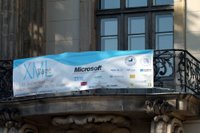
I'm just back from the XML-Tage in Berlin, an annual event dedicated to XML-Technology -- which means a real broad spectrum of topics. For being a mere 'national' event - the conference language was german - a huge number of participants showed up -- at least on the list of participants there are more than 500 entries. But, the lecture room where our sessions took place wasn't crowded at all (30 - 50 people). Interesting for me were the two invited talks: Heiner Stuckenschmitt from Uni Mannheim was asking 'what's wrong with the Semantic Web?', giving way to modular ontologies and distributed reasoning -- thus, for the semantic web we will need some distributed semantic google.... Andreas Hotho from Uni Kassel gave a presentation on bibsonomy, the well known social tagging (bibtex database) service. In the same way as del.icio.us, bibsonomy is tagging urls. But, in addition, you are able to administrate (and tag) your (and others) bibtex bibliographies...a rather useful tool for authoring scientific papers.
If everything works out well, we will cooperate with Andreas and his group by enhancing bibsonomy's features as well as by exploiting bibsonomy's database for Ontology Learning and Data Mining.

